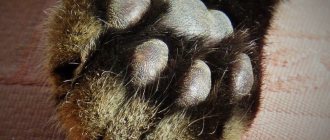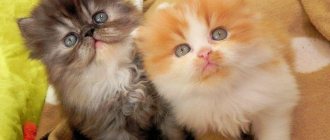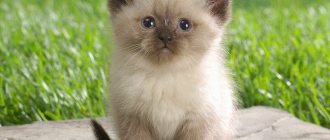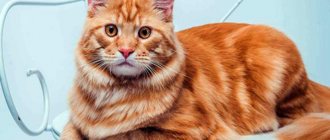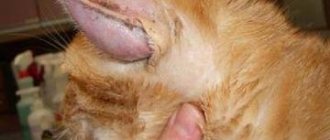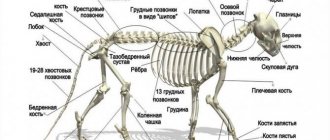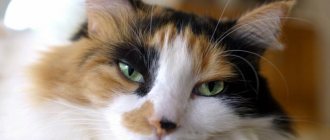- Posted by Olesya Vakhraneva
- Date: September 14, 2018
Just one useful habit, which does not require much effort and time, allows you to contact a veterinarian at the first signs of illness in your cat and not leave it alone with the disease. This is a habit of regularly paying attention to the cat's nose.
- 2 What should a healthy cat’s nose look like?
- 3 Changes in indicators, as evidenced by them
3.1 Dry nose and its causes
- 3.2 Warm or cold: what affects temperature
3.2.1 Photo gallery about nasal discharge in cats:
- 3.3.1 Photo gallery about spots on the nose of cats:
- 3.4.1 Photo gallery about the treatment of narrowing of the nasal passages:
The cat's nose is normal
What we are accustomed to calling the nose is called the nasal planum among representatives of the cat family. A unique pattern stands out on the surface, like on people’s fingertips. This pattern is unique, like fingerprints or an iris pattern. Perhaps in the future nose prints will appear as an identifier in cat documents.
A healthy, awake cat's nose is slightly moist, cold, without defects in the skin and mucous membranes .
The nasal passages are clean, breathing is free. If it is hot, this is a reason to take a closer look at the animal.
When there's no reason to worry
Concerned owners, having discovered a hot, dry nose in a cat, consider this a manifestation of the disease, which is not entirely correct. It is important to understand that dryness can be normal in the following cases:
- during sleep and within 20-30 minutes after waking up;
- when exposed to the sun for a long time, in a hot room with poor ventilation or near heating appliances;
- after physical activity and active games;
- in case of severe fear or stressful situation.
Note: in older cats, a dry nasal surface is considered normal.
In an alert state, dryness can appear even due to minor deviations in the functioning of the body (undereating or overeating, a mild cold), which go away on their own within a few hours or days.
But if the dryness of the nose does not change for a long time, you need to measure your body temperature by carefully inserting a thermometer lubricated with Vaseline into the anus. A healthy cat's body temperature fluctuates between 38-39°C. If the thermometer shows numbers lower or higher, this is already a reason to take a closer look at your pet and pay attention to the appearance of other symptoms. An elevated temperature may be a symptom of poisoning, inflammation, a viral infection, or the presence of a foreign body in the nasal passage.
What does a dry nose mean in a cat?
A cat's dry and hot nose can mean several things:
- about illness;
- on the use of medicines;
- that the cat woke up recently.
To maintain your pet's health, you need to be able to distinguish when your furry pet needs help and when it is healthy.
Signs of illness
A dry nose is far from the main symptom of the disease. However, there are many conditions where a dry, hot nose is an additional symptom. Watch the cat.
- Assess how active your pet is. There are lazy cats that refuse to play even in perfect health. A thrifty owner can easily guess whether it’s time for his mustachioed roommate to go to the clinic.
- Take a closer look at the bowls. Does the cat eat the usual amount of food, does it eat too much, does it willingly approach the bowl before feeding, does it drink more than usual.
- How often does he use the tray and what is the output?
- Is there any vomiting or diarrhea?
- Does he sit on the tray too often, or does he make unsuccessful attempts to urinate?
- The pet's coat should be smooth, shiny and clean, especially near natural openings: nose, ears, eyes and crotch area.
- There should be no mucous or, especially, purulent discharge from the eyes and nose. Sneezing and especially coughing are a reason to visit a doctor.
In some diseases, the skin of the nasal planum is affected: foci of inflammation and ulcers appear. In the vast majority of cases, this indicates a viral disease - calicivirus. You can protect your pet with regular preventive vaccinations.
Pathologies after castration and sterilization
To perform an operation, anesthesia and preparation drugs are required. Among medications, those that reduce the secretion of glands play an important role. This is necessary so that mucus does not accumulate in the bronchi of patients.
Unfortunately, the drug affects all glands, including those that moisturize the nasal planum. Some drugs directly for anesthesia have a similar property.
It is because of the action of such drugs that the nose of cats after castration or sterilization becomes dry and hot within 24 hours. This is fine.
You don’t need to talk to the surgeon about a dry nose, but the owner’s assessment of the pet’s activity, the presence of natural bowel movements, the amount of water drunk and, not before the doctor’s permission, appetite is extremely important information. It must be provided to the veterinarian at a follow-up appointment.
When there is no reason to worry
In perfectly healthy cats that are deeply asleep, the nose becomes hot. The dry state persists even after waking up. If everything else is fine with your pet, then there is no need to worry.
A dry and hot nose without additional symptoms is not a reason to go to the clinic.
The nose can be hot and dry in healthy cats when the humidity in the apartment is too low. In such cases, people use moisturizer, but animals have to endure dryness.
An air humidifier will help a lot – not only for the cat, but also for the owners. It is better to choose analog: ultrasonic irritates some mammals.
Functions of a cat's nose
The cat's nose has truly amazing properties.
Table: comparative characteristics of the sensitivity of smell
| View | Area of the olfactory epithelium | Number of olfactory receptors | Sensitivity |
| Human | 2–4 cm2 | ~5 million | Sample for comparison |
| Cat | 20 cm2 | ~200 million | 20 times better than a human |
| Dog | 170 cm2 | ~220 million | 50–1000 times better than a human |
Thus, it is clear that a cat’s nose, although weaker than a dog’s, is much more sensitive than a human’s. A cat is able not only to recognize odors hidden from humans, but also to build a complete picture of the surrounding space. Cats, unlike dogs, do not use their sense of smell to search for prey or stalk. She just doesn't need it. But for orientation in space, when communicating with relatives and people, and determining the suitability of food, it uses it with success.
This is why you should not wash your cat's bowls using chemicals. The pet will smell the substance for a very long time, and accordingly, this can lead to refusal of food. You should also be careful when cleaning your cat's litter box. It is enough to wash it with hot water in a timely manner, since high temperature destroys ammonia molecules, and the smell ceases to exist for humans. But not for a cat.
Many owners have learned to determine the quality of meat products by offering them to their cat. The fact is that the animal, carefully sniffing the food offered, easily determines its suitability for consumption. And the sausage, stuffed with preservatives and other “chemicals”, will remain untouched.
Cats love certain smells. Manufacturers know this and flavor their feed. This is what explains the passion of animals for dry food or canned food. And this is why pets so easily switch to this diet and refuse regular food.
Manufacturers of cheap dry food flavor them to make the product attractive to cats.
But the smell of orange or mothballs disgusts pets. These scents are used as repellents in all sorts of products designed to wean a cat off something.
Cats also do not like the smell of garlic and onions. At home, these finely grated vegetables can be placed in plates where the presence of cats is undesirable.
In addition to olfactory functions, a cat's nose is also intended for:
- warming and humidifying inhaled air;
- determining food temperature.
A cat is able to retain molecules of certain aromas in the nasal labyrinth in order to use the smell for its own purposes longer. Kittens use this technique with success. Being blind, they not only find the mother, but also distinguish the cat's nipples.
A newborn kitten finds its mother and her nipples solely by smell
Diagnosis and treatment
If a cat has a white or bluish nose, then there is a suspicion of anemia or cardiac pathology. A red nose may indicate injury. To identify the cause, the veterinarian listens to complaints, conducts an external examination and prescribes diagnostic procedures, depending on the preliminary diagnosis, such as:
- radiography;
- ECG;
- blood chemistry;
- scraping scales from the skin to test for fungus;
- analysis of ear discharge to detect ticks;
- polymerase chain reaction to detect herpes virus.
Cat noses are treated depending on the disease. Rhinotracheitis is incurable, but an acute attack can be treated with antibiotics or antiviral drugs, which are individually prescribed by a veterinarian. For injuries, rhinoplasty is performed or anti-inflammatory drugs are used. Special drops are prescribed against fungus or ear mites. With necrosis, dead particles are eliminated.
Examination and cleaning of the nose
It is important to remember that under no circumstances should you insert any objects not intended for inspection into the cat’s nose, including cotton swabs. If there is a need to examine the nasal passages from the inside, a specialized device is used for this - an endoscope, which is a thin tube equipped with a light and a camera. This procedure must be carried out by a specialist, always under general anesthesia, since the procedure is unpleasant and the animal will not tolerate it.
The need to clean a cat's nose only arises if she is unable to do this on her own, for example due to illness. In this situation, you should carefully clean the outer surface of the nose with a cotton swab, removing all crusts and debris, making movements from the inner edge of the nose to the outer.
Structure and functions
If we look at the structure of a cat’s nose in a simplified way, then, like a person’s, it is two nostrils that are separated by cartilage. However, inside the head, a significant part of the internal space is devoted to the nose - a whole labyrinth consisting of lattice shells of complex shape, in the nooks and crannies of which the aroma is retained and the smell is accurately identified.
In the nasal cavity, lined with the mucous membrane, there are nerves and blood vessels - this is a reliable protection of the animal’s body from bacteria and foreign bodies. The epithelium contains receptors. Air enters the body through the nostrils, through each separately, where it heats up when the cat inhales, and when exhaling, moisture is removed from the air. The air, without immediately entering the lungs, lingers in the turbinates and pores of the nose for a long time, which allows the olfactory instrument to scrupulously decompose and analyze the received aromatic information.
The structure of the cartilage and bones of the skull determines the shape of the nose. Animals with skull proportions close to natural ones have healthy noses, while pets with flat and simplified (a type of muzzle close to domestic cats) faces have compressed and curved nasal cartilage and bones, so they often suffer from diseases that attack their respiratory system.
Why does this happen?
If a cat's nose is dry and warm, this does not mean that he is sick. There are several reasons for a cat's dry nose:
- If the animal has just woken up, its nose will almost always be dry and warm. In a dream, a cat does not lick itself, which means it does not moisturize its olfactory organ. After some time, the nose will become moist and cool. This is normal and not a cause for concern.
- If the cat ran, jumped, played, or was in the open sun a lot, then his nose could dry out under the influence of his own body temperature, the air temperature indoors or outdoors, as well as from wind and dust. When the cat calms down and moves into the shade or indoors, everything will return to normal. The same applies to cases where the cat was lying near a hot radiator or in a room with excessively dry air. Central heating radiators dry out people's skin, not to mention a cat's sensitive nose.
- When it is too cold outside or indoors, the cat does not lick its nose, and it becomes cold but dry. This is also a variant of the norm. Once warm, the cat will begin to lick itself again, moistening its nose.
Cat's olfactory organ
A cat's nose is a rather complex organ that is of great importance for the animal. Things are different for cats than for people. Animals have a developed sense of smell, and the world of smells is very important for a cat. In fact, she lives in this world.
When a kitten is born, it looks for its mother’s milk by smell and remembers its den. Having matured, the cat also depends on the sense of smell - it helps it in finding food, hunting and during mating. Smells allow cats to identify their own and other people's spaces and promote communication.
A cat’s nose is a unique organ, and its sense of smell is much more sensitive than a human’s. The nose is divided by a septum into two parts, each of which leads to a labyrinth, and then smells enter the receptors.
Contamination of the organ leads to a decrease in the sense of smell, so four-legged animals carefully monitor the cleansing of the nose. Any problems with it significantly reduce the animal’s quality of life.
The animal breathes only through the nose. The air enters through the nasal openings, where it is heated and freed from unnecessary substances. The tip of the nose is called the lobe, as well as the speculum; this part is not covered with hair. The lobe is almost always wet. This is ensured by mucous secretions and regular licking. The skin of the mirror is highly sensitive to temperature, so the pet can understand whether the food is overheated without even touching it.
The color of the mirror usually harmonizes with the color of the animal, but there are exceptions. The healthiest nasal organs are in cats that have a natural muzzle shape. Cats with a flat face have breathing problems because the cartilage, due to its special shape, cannot cope with its functions.
Nasal discharge
A clear sign of the disease is nasal discharge of any nature, be it mucus, blood or liquid discharge. They may indicate the presence of a variety of infections (bacterial, fungal, upper respiratory tract infections), foreign objects in the animal’s nasal passages, allergies, mechanical injuries to the animal’s head, as well as serious diseases such as pneumonia and nasal tumors.
Sudden dental problems also often cause a variety of discharge from the nasal passages. Therefore, the appearance of any discharge from the cat’s nose should be a signal to immediately show it to a competent veterinarian, who can correctly assess the situation and prescribe effective treatment for the animal.

